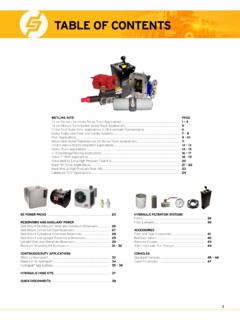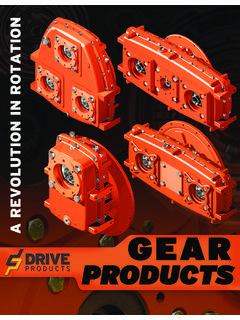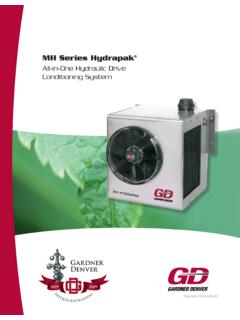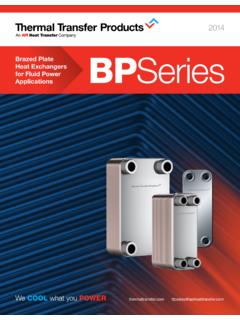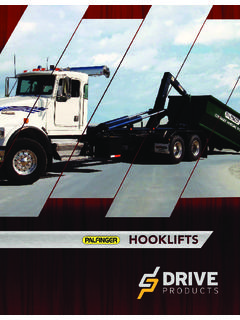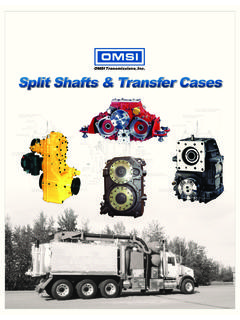Transcription of Understanding power take-off systems S i x t h e d i t i o n
1 Understanding power take-off systems Sixth edition Muncie power Products Welcome to the sixth edition of Muncie power Products' Understanding . power take-off systems , the companion piece to our Understanding . TRUCK MOUNTED HYDRAULIC systems booklet. Together these contain a body of valuable information on providing dependable auxiliary power on today's work trucks. Many sources are called upon to produce an accurate and useful technical/training publication. We thank the officers, employees, and customers of Muncie power Products for their many contributions. Special appreciation goes to Rick Wallace, power take-off Product Manager, and Muncie's engineering team in Tulsa, OK. for developing the quality PTO products that make Muncie power Products, Inc. the leader in the industry. The illustrations, design, and graphics for this booklet, as well as all of Muncie's sales and support literature, were contributed by Tony Jeroski and Mark Sherfick.
2 We encourage anyone wishing to become more familiar with Muncie power Products, Inc. to visit our web site, , to learn more about our company and products. While there be sure to click on the link to our M- power Customer Assistance Software for assistance in selecting the right Muncie PTO or hydraulic product for your application. David L. Douglass Director of Training muncie power products quality policy Muncie power Products is dedicated to providing quality products and services that will satisfy the needs and expectations of our customers. We are committed to the continual improvement of our products and processes to achieve our quality objectives, minimize costs to our customers and realize a reasonable profit that will provide a stable future for our employees. Table of Contents power take-off Defined 3. power Take-Offs A Brief History 4. The Transmission Aperture 6.
3 The power take-off Input Gear 7. PTO Speed and Rotation 8. PTO Selection 9. The Muncie PTO Model Number 11. PTO Torque and Horsepower Requirements 13. Adapter Gear Assemblies 14. Intermittent and Continuous Duty Cycles 15. Types of power Take-Offs 17. PTO Installation Backlash 18.. power take-off Defined power Take-Offs (PTOs) are mechanical gearboxes that Truck Classification By GVWR. attach to apertures provided on truck transmissions and (Gross Vehicle Weight Rating). are used to transfer the power of the vehicle engine to Class 1 Less than 6,000 lb. auxiliary components, most commonly a hydraulic pump. The hydraulic flow generated by the pump is then directed Class 2 6,001-10,000 lb. to cylinders and/or hydraulic motors to perform work. In Class 3 10,001-14,000 lb. some PTO applications such as generators, air compres- Class 4 14,001-16,000 lb. sors, pneumatic blowers, vacuum pumps and liquid trans- Class 5 16,001-19,500 lb.
4 Fer pumps, the PTO provides power , in the form of a rotat- Class 6 19,501-26,000 lb. ing shaft, directly to the driven component. Class 7 26,001-33,000 lb. The power take-off we are most familiar with is the side- Class 8 33,000 lb. and up mounted PTO, although there are also models that attach to the rear of certain transmissions and split shaft PTOs that are mounted by removing a section of the vehicle's main driveline. Rear-mounted PTOs are frequently referred to as countershaft PTOs although, in truth, many side- mounted PTOs are also driven by gears on the transmis- sion's countershaft and so are also countershaft PTOs. You may hear people refer to side countershaft and rear countershaft power take-offs to make a distinction. Transmission with PTO and The transmissions commonly found in class 4 and larger hydraulic pump installed. vehicles will have provisions for the mounting of a PTO.
5 Generally there are two apertures, one on each side of the transmission, although some smaller transmissions may have only one. When discussing aperture location one re- fers to the passenger side of the truck as the right and the driver's side as the left . Many popular Eaton Fuller transmissions have a PTO aperture on the bottom (offset to the left), and some Allison automatic transmissions have Air Shift Cover a top aperture. The power take-off may be engaged by means of a cable, lever, air pressure, or hydraulic pressure. The latest PTO. shifting design incorporates a small electric motor and hy- draulic pump within the shift cover assembly to provide hydraulic force to engage the PTO. Cable Shift Cover Various output shaft configurations are available to allow for a driveshaft connection or the attachment of hydraulic pumps directly to the PTO without an intermediate shaft.
6 The Society of Automotive Engineers ( ) has estab- lished standard mounting face dimensions for hydraulic pumps and PTOs are made to accept these. These are referred to, from smallest to largest, as the A, B, D, Lectra Shift Cover E and F.. power Take-Offs A Brief History The earliest documented use we have of a power take-off is 1919 when a PTO was utilized to power an air compres- sor to inflate tires on a Cadillac automobile. By the 1930s PTO apertures were standard on truck transmissions and 828 power take-offs were being used to power winches, dump bodies, and garbage trucks. Early PTO manufacturers in- cluded Gar Wood, Central Fiber Products, Spicer, Tulsa Winch, Arrow, and Braden. These early manufacturers no longer exist as PTO manufacturers. Braden and Tulsa Winch still exist as successful manufacturers of mechani- 838 cal and hydraulic winches. Eventually, Central Fiber and Spicer were acquired by Dana Corporation and their PTO.
7 Products were combined into the Chelsea PTO line. Park- er Hannifin Corporation now owns Chelsea. Muncie power Products began in Muncie, Indiana in 1935. as Muncie Parts Manufacturing Company, a distributor of CD10 auto parts. By the late 1930s the company developed an interest in power take-offs and by the 1960s began an ex- pansion that would make Muncie the largest PTO distribu- tor in North America. The company name changed to Mun- cie power Products, Inc. in 1979. In 1981 Muncie power , CS6 until then a distributor for Dana's Chelsea line, entered into a partnership with the Tulsa Winch Company and began manufacture of new PTO designs under the Muncie name. In 1986 Muncie purchased the Tulsa manufacturing facility from its parent company. In 1999 Muncie joined the Inter- pump Group to become, along with two other Interpump Group PTO manufacturers, PZB and Hydrocar, a part of CS10 the worlds largest PTO power take-off manufacturing en- tity.
8 The original power take-off was a single gear unit with a gear that slid into mesh with a transmission gear, result- ing in output shaft rotation. Single gear PTOs are still marketed today although their popularity is greatly dimin- ished. Single gear PTOs are inexpensive and simple to CS20 service. However, they lack many of the features, such as the ability to accept direct-coupled hydraulic pumps that are popular with today's truck equipment installers. Single gear PTOs also are limited by their torque and horsepower capabilities. You will find them used primarily on single axle dump trucks and agricultural hoists. FR. Multi-gear power take-offs, like the Muncie TG series, are the most common type of PTO because of their ver- satility. This type of PTO offers the user many features, such as direct pump mounting, shifter choice, and numer- RG. ous speed ratios and horsepower capabilities that make.
9 It an ideal choice for almost any type of truck mounted equipment. This common PTO is found on dump trucks, roll-off hoists, wreckers, aerial bucket trucks, tank trucks, and truck mounted cranes. Reversible PTOs are another type that is experiencing decreasing popularity. Traditionally, reversible PTOs were used to provide power in two directions to mechanical winches and liquid transfer pumps. As hydraulic drives re- RS. place mechanical in these applications there is less need for the reversible power take-off . One remaining benefit to reversible models is that they can be used in applications where a rotation opposite that provided by the standard multiple gear PTO is required. Care must be taken, how- ever, not to exceed the PTO's torque capacity, which, in SG. its reverse gear, is often similar to that of the single gear PTO. 8-Bolt power take-offs are the largest PTOs, providing torque capacities of up to 500 These PTOs are used for high torque applications such as pneumatic blowers, vacuum pumps, and large winches.
10 8-bolt PTOs are avail- TG. able in both single speed and reversible models. Hydrau- lic pumps can be direct coupled and the PTO can be air actuated. The newest design power take-offs are the clutch type. Commonly called Clutch Shift , power Shift , or Hot Shift PTOs, these models engage by means of friction disks rather than sliding gears. Used for many years on SS66. Allison automatic transmissions, this type of PTO can also be fitted to many popular manual transmissions. Clutch type PTOs offer many advantages over traditional multiple gear models, not the least of which is their ability to be engaged and disengaged with the vehicle in motion. This feature also does much to prevent accidental PTO SH. and transmission damage from improper shifting prac- tices. While clutch type power take-offs cost more than multiple gear models initially, their increased torque and horsepower ratings, along with the added safety benefits, make them worthy of consideration, particularly on expen- sive automatic transmissions.

